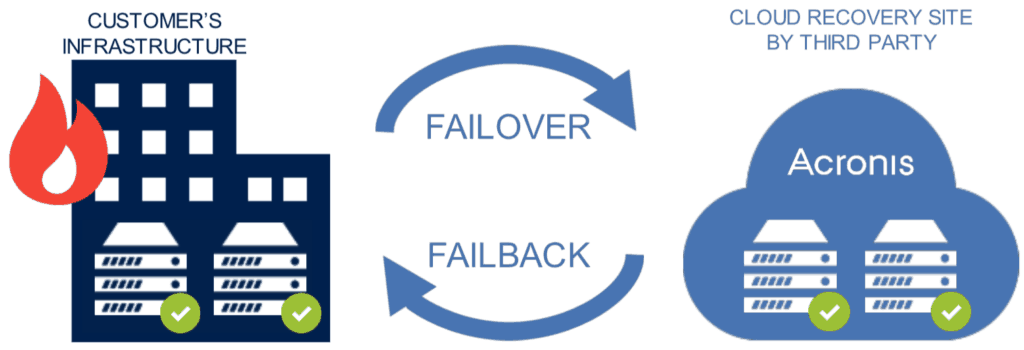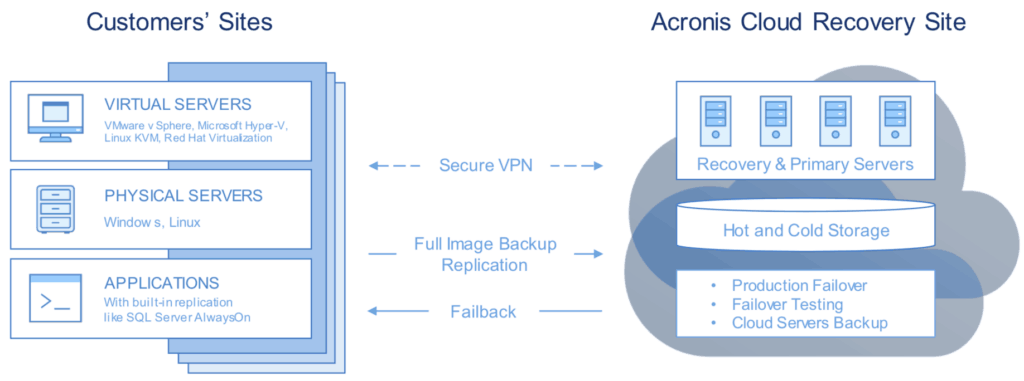
Acronis Disaster Recovery Cloud
Acronis Disaster Recovery Cloud is a turnkey, self-service solution, built upon Acronis Backup Cloud, that lets you protect your critical workloads by instantly recovering their critical IT systems, applications, and data utilizing the Acronis cloud infrastructure.
[btnsx id=”6974″] [btnsx id=”2931″]
[btnsx id=”6958″]
Both Cloud and Local Recovery
Disaster Recovery: Key Features
| Cloud Servers for Application-Level Replication
For applications with built-in replication technology, quickly add virtual machines in the Acronis cloud using a set of Window or Linux VM templates to host replicas of the applications. |
Protection for On-Premise and Cloud Workloads
Acronis Disaster Recovery Cloud protects your customers’ systems in any location and in any environment — on your clients’ premises, in remote systems, and in private and public clouds. |
Intuitive Web-Based Console
You can use the Acronis-hosted, touch-friendly, web-based console to perform most activities related to disaster recovery, including configuring the network, testing, failover, and failback. |
| Straightforward Network Configuration
Using Acronis’ VPN virtual appliance and network parameter auto-discovery capabilities, you can easily extend your client’s network to the Acronis cloud and provide transparent remote access to recovery servers. |
Isolated Testing Environment
For non-disruptive testing of a failover, start recovery servers in the Acronis cloud testing environment and keep testing isolated from the production network. |
Ready Solution
Acronis Disaster Recovery Cloud includes a broad set of features, including a multi-tenant architecture, per-customer reporting, a RESTful API, and integration with your business automation systems. |
One solution for any workload
|
Physical and virtual machines |
♦ Windows |
♦ Linux |
| Virtualization platforms |
♦ VMware vSphere ♦ Microsoft Hyper-V ♦ Oracle x86 VM Server |
♦ Linux KVM ♦ Citrix XenServer ♦ Red Hat Virtualization |
| Applications |
♦ Microsoft Exchange ♦ Microsoft Active Directory |
♦ Microsoft SharePoint ♦ Microsoft SQL Server |
Built on Acronis Data Cloud
Acronis Data Cloud is a platform that delivers data protection services with an unprecedented level of ease. With one solution, you and your customers gain access to backup, disaster recovery, file sync and share, notarization and e-signature services, all managed from a single console. These in-demand, add-on services mean you can sell more and increase your customer retention.
[btnsx id=”6974″] [btnsx id=”2931″]
What is Disaster Recovery as a Service?
Disaster Recovery as a Service (DRaaS) is the replication and hosting of physical or virtual servers by a third party to provide fail over in the event of a man-made or natural catastrophe.
Who Needs DRaaS?
|
Companies that: |
Key industries: |
|
|
|
|
|
|
|
|
|
|
|
|
|
DRaaS vs DIY Disaster Recovery
Disaster Recovery vs Backup
|
Backup |
Disaster Recovery |
|
|
Key functions |
Protection of data from loss |
♦ High availability of critical applications ♦ Rapid recovery after a disaster |
|
Target devices |
Servers, workstations, mobile devices |
Critical servers and virtual appliances |
|
Recovery requirements |
|
♦ Quickly fail over critical workloads to an offsite environment ♦ Fail back to a primary site |
|
Required infrastructure |
Secure local and offsite storage |
♦ High-performance offsite storage ♦ Compute and networking resources ♦ DR orchestration software |
|
Storage type |
Local and/or offsite cold storage |
Offsite hot storage |
|
RTO in case of disaster |
Slow |
Fast |
|
Usage frequency |
Often |
Rarely |
Straightforward Pay-As-You-Go Pricing
The Acronis Disaster Recovery Cloud licensing and pricing was developed with the needs of clients in mind:
|
♦ With a pay-as-you-go model, you pay only for the servers you are protecting and only when you need it |
♦ Per-GB storage price doesn’t depend on the number of recovery servers and their configurations |
| ♦ Charges for compute resources apply only while the recovery server is running | ♦ Compute resource consumption is aggregated over a month with one- minute granularity |
| ♦ Pricing offers the same discount tiers and commitment levels as Acronis Backup Cloud | ♦ Pricing is available in all standard currencies |
Acronis Disaster Recovery Cloud Licensing
Licensing highlights
♦ Built on top of Acronis Backup Cloud pricing, applies to the same commitment levels
♦ Per GB-based SKU for paying for the DR infrastructure
♦ Charges for compute resources apply only while the recovery server is running
♦ Available in all standard currencies
♦ Free trial available by request as part of an Acronis Backup Cloud trial
Monthly billings structure:
|
Backup Storage (*) |
+ |
DR Storage (*) |
+ |
Compute |
+ |
DR IP Address (Optional) |
|
€ 0.18 per GB per month for all VMs protected either with backup or DR |
€ 0.36 GB per month for all VMs protected with DR |
From €0.045 per hour, but only for the time the VMs are active |
€ 5,40 per IP per month for all external facing IPs provided by Acronis |
|
(*) Simplified pricing: ◊ No matter how many VMs you have |
Acronis Disaster Recovery Cloud SKUs
SKU Descriptions
|
New Product Name |
Description |
|
Acronis Disaster Recovery Cloud —Acronis Hosted (per GB) |
Disaster Recovery Storage is the backup size in the latest recovery point per protected server and VM |
|
Acronis Disaster Recovery Cloud — one compute point (per running hour) |
Compute resources are standard pre- configured vCPU and RAM configurations with assigned per-hour compute values |
|
DR IP |
Dedicated public-facing IP addresses can be optionally added to servers that require external network access |
Compute Configurations
|
Type |
vCPU |
RAM |
Per-hour Points* |
| F1 |
1 vCPU |
2 GB |
1 Point |
| F2 | 1 vCPU |
4 GB |
2 Points |
| F3 | 2 vCPU |
8GB |
4 Points |
| F4 | 4 vCPU |
16 GB |
8 Points |
| F5 | 8 vCPU |
32 GB |
16 Points |
| F6 | 16 vCPU |
64 GB |
32 Points |
| F7 | 16 vCPU |
128 GB |
64 Points |
| F8 | 16 vCPU |
256 GB |
128 Points |
* Fractional compute points are calculated throughout the month ((minutes used / 60 minutes) x configuration points), then rounded up to the nearest point at the end of the billing month.






















